The movement and logistics industry is becoming increasingly difficult. As companies grow and their supply chain management operations expand across broader geographic areas, managing freight effectively has become more challenging. Transporters and logistics providers are under constant pressure to ensure operations run at peak performance, often relying on outdated tools and manual processes.
This is where a Transportation Management System (TMS) adds value not as a luxury, but as a critical component of transportation and logistics systems in today’s digital age. A TMS is more than just a tool; it's an automated transportation management system that brings structure, speed, and visibility to the entire freight lifecycle from planning to execution, settlement, and transportation route optimization.
In this blog, we’ll explore what a TMS is, the problems it solves daily, and why companies are adopting custom transportation management systems, on-premise TMS software to stay agile and scalable in a fast-evolving logistics environment.
What Is a TMS? And Why Does It Matter in Modern Logistics?
A Transportation Management System (TMS) is a powerful piece of transportation management system software designed to streamline freight management operations. Whether you're moving freight domestically or globally, a TMS serves as the central hub to orchestrate, execute, track, and analyze transport-related tasks in real time.
Think of it as your logistics management system control tower, replacing spreadsheets, phone calls, and manual coordination with smart dashboards and automation. You can select carriers, automate updates, optimize delivery paths, and execute payments all within one platform.
A robust TMS:
Lowers Freight Costs
By optimizing load planning, automating carrier selection, and consolidating shipments, organizations can minimize fuel consumption, empty miles, and inefficient routing. These capabilities are core to any automated transportation management system, resulting in measurable operational savings.
Automates Manual Processes
A modern TMS eliminates redundant paperwork and manual intervention. From dispatch creation to digital proof of delivery and e-invoicing, everything is streamlined. This level of logistics automation significantly reduces errors and administrative overhead.
Improves Delivery Performance
With real-time tracking and automated alerts, your team can act proactively when disruptions occur. Delays can be detected and rerouted early. This ensures better SLA compliance and reliability, all enabled through a best transportation management system.
Provides Real-Time Visibility
TMS delivers visibility into the shipment process from the time it is scheduled to when it is delivered. Visibility can be accessed to see the status of a shipment, receive proactive updates to receive, and make decisions can be made without guessing.
Enables Freight Audit and Billing Accuracy
Through its embedded verification and reconciliation functionalities, a TMS authenticates every invoice to properly capture services rendered. Hence, it minimizes the chances of overpayment, disputes, and loss of cash.
Integrates with ERPs, WMS, GPS, and E-invoicing Systems
A robust TMS is not standalone; it seamlessly connects to systems like SAP, Oracle, or Microsoft Dynamics, enabling smooth ERP WMS integration. This allows data to flow freely across procurement, inventory, and compliance, a must for organizations pursuing custom ERP TMS integration.
Ultimately, a modern TMS transportation management system empowers logistics teams to work smarter. Whether through automation or real-time insight, it allows businesses to maintain competitiveness, especially in an era defined by rising expectations and shrinking margins.
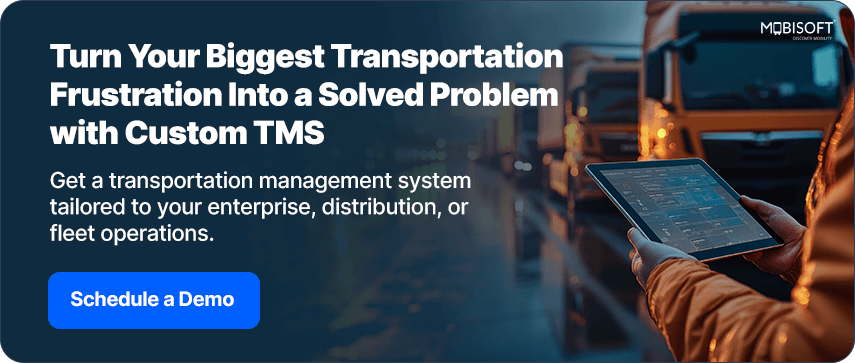
Types of TMS Solutions: A Comparative Overview
| TMS Type | Description | Pros |
| Off-the-Shelf | Pre-built SaaS or cloud-based | Quick to deploy, scalable |
| On-Premise | Installed on local servers | Full data control, high performance |
| Custom TMS | Built from scratch | 100% aligned with business needs |
| White-Label TMS | Custom TMS with client branding | Full brand control, tailored workflows |
Real-World Logistics Challenges and How a TMS Solves Them
Logistics today is far from a one-size-fits-all affair. Companies, carriers, and distributors all have their own sets of operational issues, the majority of which stem from outdated transportation and logistics systems, legacy tools, and a lack of real-time visibility
Let's examine the issues in particular that each stakeholder has and how a Transportation Management System (TMS) provides particular, real-world solutions.
TMS Solutions For Enterprises
The Challenges
Manual freight booking and poor visibility
Supply chains in business usually rely on email, spreadsheets, or old ERP modules to plan and track freight. These outdated processes hinder effective supply chain management and lead to delays, missed shipments, and poor shipment tracking once products leave the warehouse.
Frequent discrepancies in billing
When freight information is dispersed across systems, payment of invoices against actual freight movement is time-consuming and prone to errors. Rate disputes, accessorials, or proof of delivery (POD) failures hold up payment and destroy vendor relationships.
Ineffective management of transporters, SLAs, or contracts
Businesses often deal with multiple carriers, each having different rate cards and SLAs. Without a centralized transportation management system software, enforcing compliance and tracking performance becomes almost impossible.
Fragmented data across multiple systems
Key data is scattered across ERPs, WMS platforms, Excel files, and shipment records. Without integrated ERP WMS integration, it’s impossible to consolidate a full view of performance, cost, and delivery schedules.
TMS Solutions
Centralized order-to-invoice visibility
A TMS gives you one dashboard to monitor orders from booking through billing. No more toggling between systems; stakeholders have visibility into freight status, delays, and cost information in one location.
SLA, contract, and rate card management
All transporter contracts and rate plans are kept electronically, with real-time compliance. The system notifies any violation of service level agreements or rate changes in real-time and helps procurement and logistics personnel to stay compliant.
Document workflows (LR, POD, e-invoice)
Create, distribute, and archive documents such as lorry receipts, delivery confirmation, and e-invoicing in the platform. It eliminates paperwork, accelerates reconciliation, and simplifies audit readiness.
End-to-end analytics and audit trail
Drill into historical performance data, carrier scorecards, and cost trends. Everything is mapped, so compliance and internal audits are simpler and quicker.
TMS Solutions for Transporters
The Challenges
No visibility into vehicle allocation, deliveries, or fuel
Fleet managers often lack tools to track vehicle movement, fuel efficiency, or load optimization. Without access to a track and trace TMS, optimization is based on guesswork.
Payment delays due to paperwork gaps
Invoices get delayed because of a lack of PODs, a lack of trip data, or improper route documentation. This impacts the transporter's cash flow as well as customer credibility.
No centralized record of drivers or vehicles
Manually tracking licenses, permits, and insurance often leads to compliance lapses and missed renewals. A digital logistics automation setup can prevent these issues.
TMS Solutions
GPS/IoT tracking, predictive ETAs
GPS and IoT device-based real-time location tracking provides end-to-end visibility of vehicle travel. Predictive ETAs facilitate customer expectation management and early notification of delays.
Digital driver and vehicle records
There needs to be a master database in electronic format, with all the drivers, vehicles, and related compliance history. It automatically generates renewal reminders and indicates expired licenses and insurance lapses.
Freight bidding and route optimization
Transporters are provided with trips, bid online, and are assigned routes based on availability and cost-effectiveness. Dynamic route planning is offered with fuel-efficient, on-time deliveries.
POD-based billing automation
Once the delivery proof is posted through the web or mobile, automatic billing is initiated. Much paperwork is eliminated, and payment delays are avoided.
Additionally, integrating a real-time vehicle tracking system ensures continuous visibility into vehicle movement and route efficiency. It empowers fleet managers with accurate, real-time data for better decision-making and improved delivery accuracy.
TMS Solutions For Distribution Management
The Challenges
Poor load planning and delivery consolidation
Without effective planning aids, shipments depart half-full or on suboptimal routes. This raises transportation costs and puts available resources to the test.
Underutilized vehicles and stock misalignment
Delivery trucks are underutilized due to ineffective dispatching or the lack of inventory in the right places at the right times.
SLA misses affecting customer service
Missed delivery windows, stockouts, or partially filled deliveries all directly affect customer experience. Root cause visibility, without which, issues linger and recur.
TMS Solutions
Smart load & route planning
The TMS employs artificial intelligence and past information to recommend the most beneficial load assignments and route pairs. It considers delivery windows, traffic, and capacity restrictions.
Multi-order consolidation and dispatch automation
Orders destined for the same locations are batched and scheduled automatically together. This minimizes trips, maximizes delivery density, and lowers the cost per shipment.
Real-time alerts and dashboards
Receive real-time alerts for route delays, missed scans, or delivery exceptions. Custom dashboards display key transportation management system (TMS) performance indicators, enabling teams to resolve issues before they escalate. a critical feature for both custom TMS and white label SaaS logistics platforms.
Off-the-Shelf vs. Custom Transportation Management System: Flexibility Comparison
| Feature Area | Off-the-Shelf TMS | Custom TMS |
| Integration | Standard ERPs only | Any ERP, WMS, CRM, or billing via APIs (ideal for custom ERP TMS integration) |
| Workflows | Predefined | Business-specific workflows and milestones |
| Roles & Access | Generic roles | Custom user roles, access hierarchies |
| Document Flows | Fixed templates | Custom LR, POD, GRN, invoices |
| Localization | Limited | Multi-language and unit conversions |
| Deployment | Cloud-only | On-premise, hybrid, or private cloud (suited for on-premises TMS software) |
The Value of On-Premise TMS Software: Data Control, Compliance & Resilience
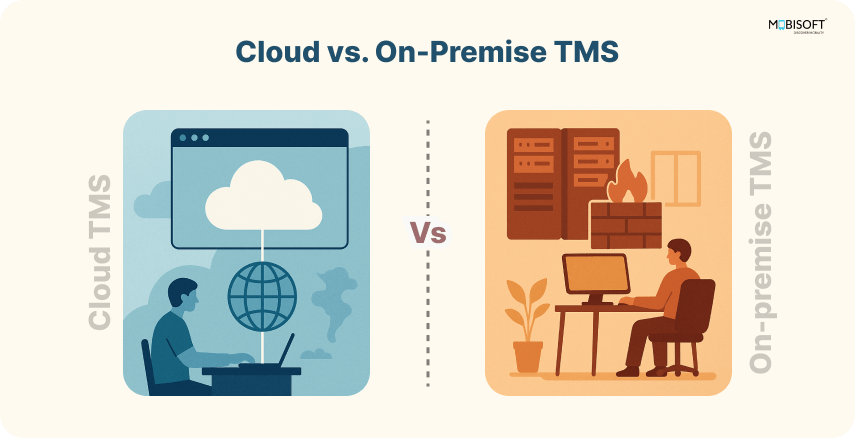
In manufacturing, pharma, retail, and energy sectors where shipment timing and sensitive data cannot be compromised, an on-premise Transportation Management System (TMS) offers unmatched control, privacy, and reliability. This is where a white label logistics platform can also be deployed privately for greater ownership.
An on-premise TMS runs on your IT infrastructure and on-premises, unlike a cloud. Here, you own the data and have ownership over all aspects of storage, access, and data security. This is a significant advantage for organizations and sectors that have strict data governance regulations, a common requirement for an enterprise transportation management system.
Key Benefits of On-Premise
Security: Total control over data, no third-party access
Having systems and data under your control, regardless of the cloud or third-party organization, greatly minimizes your exposure to attack. Being in control allows you to manage sensitive shipping data securely and reduces reliance on external entities, a core benefit of enterprise on-premises TMS deployment.
Compliance: Meets GDPR, ISO 27001, and SOC 2 standards
With on-premises support, you're able to build an IT infrastructure that aligns with strict compliance frameworks like GDPR, ISO 27001, and SOC 2. Since you own the infrastructure, it's easier to apply internal policies and perform audits, a crucial capability for businesses using on-premises TMS software in regulated industries.
Performance: High-speed processing with no internet dependency
On-premise TMS solutions can deliver immediate processing times. You are not subjected to constraints relating to internet bandwidth or a cloud service being down, a benefit in scenarios that require immediate decisions to ensure maximum efficiency in logistics.
Offline Ops: Ideal for rural or remote operations with weak connectivity
Ideal for remote locations, rural distribution centers, or mining/logistics operations in areas where they're struggling to get decent connectivity. Even without an internet connection, everything operates without interruption to fleet integrity and shipment tracking.
This form of performance, privacy, and dependability makes an on-premise TMS a solid foundation for organizations that prize uptime and control of their data.
Why a White-Label Transportation Management System Is a Strategic Asset?
For 3PL, freight brokers, and logistics service providers, technology is more than just back-office operations; it's a brand differentiator. A white label transportation management system enables you to leverage a robust logistics platform and deliver it, branded, with a customized user experience tailored to your customers and partners.
Instead of asking your customers to shift to third-party portals, you provide them with a seamless platform where you can both convey your value proposition and make them feel more comfortable interacting with you.
The White-Label Transportation Management System, You Can
Own the Brand Experience End-to-End
From login screens to reports and notifications, all bear your company's brand logo, color palette, and messaging, upholding brand recognition and credibility.
Provide customized portals for shippers, transporters, and drivers
Tailor access and functionality to shippers, transporters, and drivers based on their respective needs. This tailoring enhances usage and involvement.
Offer logistics as a value-added service
Along with mere product transportation, you now provide visibility, automation, and digital control as inherent aspects of your service. This transformation turns you into a technology-conscious partner and not a mere vendor.
Build long-term client loyalty through digital integration
The digital environment gets sticky. As customers come onto your platform for operations, reporting, and collaboration, switching is less likely, and it results in better retention and long-term relationships.
Essentially, a white label logistics platform repositions your logistics company as a digital solutions company, building a competitive advantage that is difficult to copy.
Custom Transportation Management System = ROI Through Logistics Process Transformation
The real strength of an in-house-developed TMS lies not so much in automating current processes but in actually changing the nature of logistic activities.
As opposed to off-the-shelf solutions that require you to bend your workflows to fit, a custom transportation management system is integrated into your specific business model, whether that is multi-client dispatch management, split invoicing, regional tax logic, or custom ERP TMS integration for warehouse connections.
Measured Gains
40–60% Reduction in Manual Processes
Everything from quote to billing enables automation to limit the need for manual involvement and allows teams to focus on exceptions and strategic decision-making.
5–15% savings through route/load optimization
Dynamic planning allows better route choice, better use of vehicles, and less empty running, which reduces fuel expense directly while increasing margins.
Shorter billing cycles, from weeks to days
It took weeks to pursue PODs, rate settlements, and generate invoices, but it only took days to accomplish using automated documents and processes.
10–25% improvement in on-time delivery
Predictive tracking, real-time notification, and dispatch optimization reduce delay and enable better SLA performance, resulting in improved customer satisfaction.
Improved driver and transporter compliance
With centralized record keeping, permit and license tracking, and automatic confirmations, there have been quantifiable improvements in rates of compliance by drivers and transporters.
In the end, a dedicated TMS becomes more than a tool; it is a strategic asset enabling efficiency, profitability, and long-term scalability.
Advanced TMS Modules That Solve Industry Challenges
| Module | What It Solves |
| Order Management | Fragmented shipments, inconsistent load scheduling |
| Smart Load Building | Truck underutilization, rising freight per km |
| Route Optimization | Missed delivery windows, high mileage |
| Freight Bidding | Unstructured procurement, inflated costs |
| Invoice Reconciliation | Disputes, incorrect payments |
| Contract Management | Missed SLAs, misaligned rates |
| Vehicle Maintenance & Fuel | Breakdowns, fuel inefficiency |
| Driver Compliance & Health | Safety issues, documentation gaps |
| Real-Time Visibility | Delays, lack of tracking |
| Document Automation | Delays due to manual paperwork |
| Analytics & Exception Mgmt | No control tower, a lack of decision insights |
AI-Ready Architecture: Why Custom TMS Prepares You for the Future
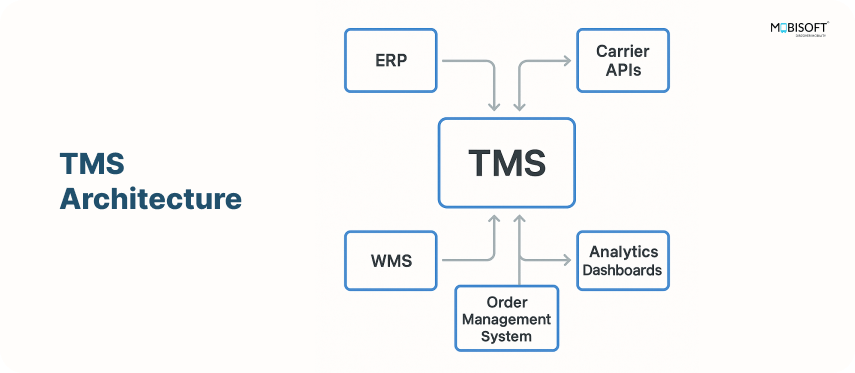
As logistics becomes increasingly more dependent on data and driven by automation, a Transportation Management System (TMS) needs to do more than just execute your established workflows. Logistics will be driven by Artificial Intelligence (AI) and powered by Machine Learning (ML), and your system needs to facilitate that evolution from day one.
A modern TMS offers the power of smart automation end-to-end across the logistics management system life cycle. With information organized to be utilized, workflows mapped, and integrations smooth, organizations are better equipped to make faster and smarter decisions across the company a key benefit of investing in a custom transportation management system.
AI Capabilities Enabled by TMS:
Predictive ETAs and fuel consumption
AI will consider live traffic, historical route data, current vehicle status, driver behavior, and other variables to predict accurate delivery times. It will also optimize routes to minimize fuel consumption, saving on costs while producing outcomes that promote sustainable practices.
Smart freight allocation based on historical data
AI can automatically suggest best-fit carriers or routes for shipments by assessing past shipment data, carrier performance, and transportation efficiency; non-AI TMS relies on manual decision-making based on historical data. This accelerates and streamlines load planning with more speed and precision.
Real-time delay forecasting
Artificial intelligence (AI) platforms can scan many variables (weather, traffic, port delays) to detect potentially delayed shipments in real time. Operations teams are typically alerted ahead of time to reroute shipments or alert clients/stakeholders before service levels are affected.
Document recognition (PODs, invoices)
Machine learning (ML) can process data from documents like Proof of Delivery (PODs), invoices, and e-way bills to extract and analyze key processing data. This has reduced manual data entries, sped up billing processes, and also reduced the opportunities for manual data errors.
AI is changing how logistics teams perform their jobs. However, AI is heavily reliant on high-quality structured data and flexible workflows.
Custom-built TMS has always allowed for flexible and structured data management by design, hence integrating AI solutions into the software works smoothly and can be scaled accordingly to provide massive levels of operational intelligence. This approach helps to give you a leg up in a fast-moving logistics environment shaped by the future of logistics technology.
Industry Use Cases: How Transportation Management Systems Support Manufacturing, Retail, Pharma & Transport
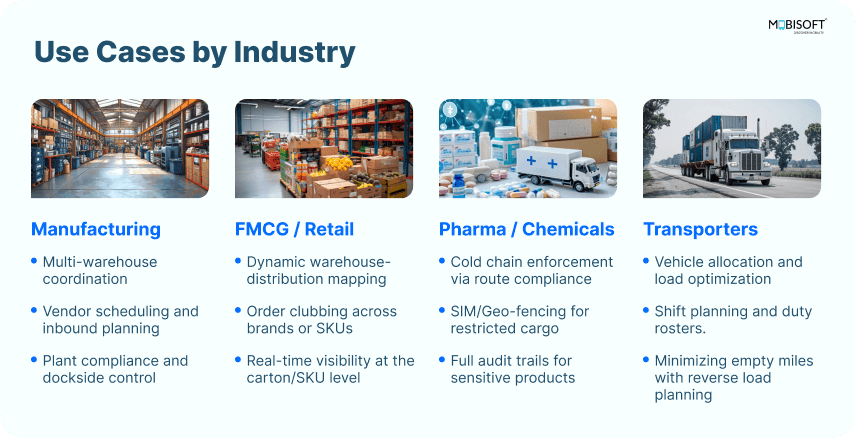
A well-thought-out Transportation Management System does not take a one-size-fits-all stance; instead, it fits the unique logistics needs of each sector.
Here's how different industries can tap into value by leveraging tailored TMS use cases:
Manufacturing
Producers work in high-volume, time-critical settings. A TMS assists them in keeping operations flowing smoothly and in line between facilities.
Multi-warehouse coordination
Sync inventory across various production units and warehouses to achieve quicker response times and reduced inventory holding costs.
Vendor scheduling and inbound planning
Maximize procurement slot bookings, align incoming deliveries with production schedules, and reduce plant downtime due to late materials.
Plant compliance and dockside control
Gather real-time insight into dock activities, safety procedures, and regulatory compliance, particularly for highly regulated industries.
FMCG / Retail
With narrow delivery windows and continuous demand shifts, FMCG players and retailers require speed and agility. A rebooted TMS keeps them agile.
Dynamic warehouse-distribution mapping
Direct orders through the most efficient warehouse, depending on location, availability, and demand, to minimize delivery times.
Order clubbing across brands or SKUs
Consolidate various small orders placed by the same region or customer into one shipment to save costs and improve operational effectiveness.
Real-time visibility at the carton/SKU level
Monitor each unit in close detail to discourage shrinkage, prevent discrepancies, and ensure a high level of fulfillment accuracy. This real-time visibility is a strong value-add in logistics automation.
Pharma / Chemicals
This highly regulated and sensitive sector requires transparency, traceability, and strict management of transport conditions.
Cold chain enforcement via route compliance
Keep temperature-sensitive products in transit with route verification, sensor connectivity, and real-time compliance monitoring.
SIM/Geo-fencing for restricted cargo
Manage the movement and access of sensitive information through SIM-based authentication and geo-fencing, safe, authorized passage.
Full audit trails for sensitive products
Allow complete traceability of vital freight to meet health legislation requirements and guarantee accountability at each transfer point.
Transporters
To transporters, the keys to profitability are efficiency and utilization. An optimized TMS does both to the maximum.
Vehicle allocation and load optimization
Match the right vehicle to the right load and route, maximizing fleet efficiency and reducing operating costs.
Shift planning and duty rosters.
Automate driver assignment by availability, compliance, and rest needs, keeping operations running smoothly and compliant.
Minimizing empty miles with reverse load planning
Find return-trip opportunities to transport vehicles that otherwise would have to make empty trips, maximize revenue per trip, and minimize waste.
Supporting Sustainability & ESG Goals with a Transportation Management System
In addition to mere efficiency, contemporary transportation management system (TMS) solutions are also powerful drivers of environmental and social sustainability. Since companies desire to align themselves with international ESG (Environmental, Social, and Governance) standards, digital transportation management solutions offer tangible means of enhancing these efforts.
A digital TMS transportation management system supports ESG and carbon footprint reduction through:
Fewer fuel results from better truck utilization
A TMS minimizes fuel use, emissions, and travel-related expenses by means of load optimization and fewer empty trips.
Reduction of Records
Cutting down on physical papers and helping to achieve green logistics objectives are digital documents such as ePODs, eInvoices, and electronic receipts.
Increased Visibility Reduces Idle Hours
Live tracking and more intelligent dispatching minimize vehicle downtime at warehouses or loading docks, hence lowering emissions and improving driver output.
Monitoring fuel helps to lower emissions.
Integrated fuel monitoring guarantees compliance with sustainability goals, detects inefficiencies, and controls consumption.
Data-driven route and asset optimization
Better vehicle deployment, energy-efficient routes, and more intelligent delivery clusters all help to reduce the carbon footprint.
Final Thoughts: Build for Control, Flexibility, and Growth
For basic needs, off-the-shelf solutions may be sufficient; however, with complex supply chains, dispersed operations, or high compliance challenges, generic tools cannot come near. That is exactly where custom transportation management system platforms shine; the contrast is obvious.
Custom, on-premise, and white-label TMS offerings give you the ability to:
- Full control of data and logic: Own your infrastructure, workflows, and business rules, no vendor lock-in, no compromises.
- High compliance and security: Comply with strict industry requirements and data protection regulations with accuracy and assurance.
- Modular scalability: Start with what you need today, and scale effortlessly as your business, partners, and geographies grow.
- True brand ownership: Offer an uninterrupted, branded digital experience for the shipper, transporter, and driver portals.
- Seamless collaboration between all stakeholders: Involve every participant in your supply chain in logistics with real-time information and automated processes that eliminate barriers.
A future-ready supply chain starts with a TMS built for efficient transportation management, scalability, and full control.
Let’s build smarter logistics, one custom workflow at a time.
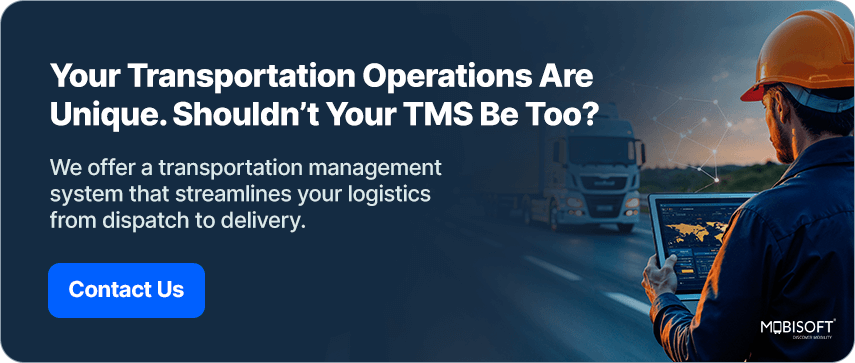

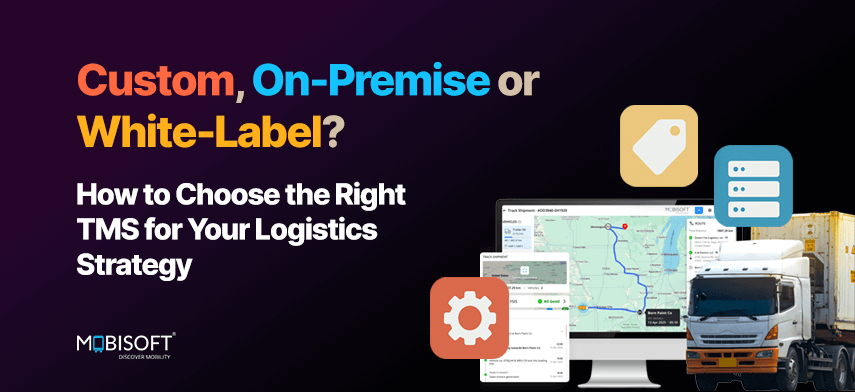


 July 2, 2025
July 2, 2025


